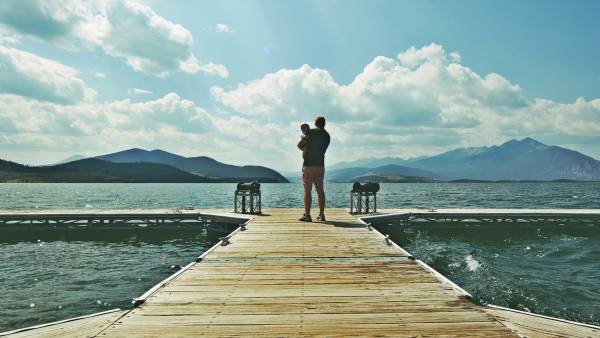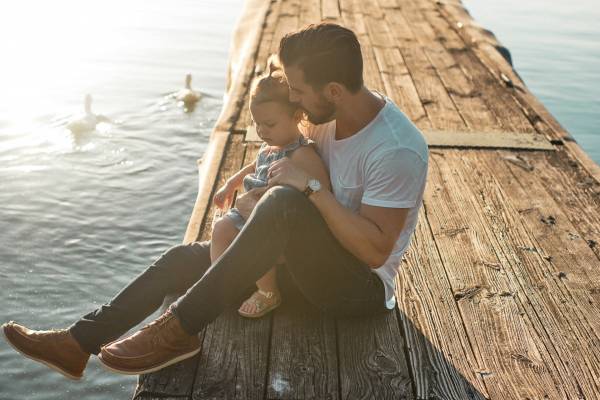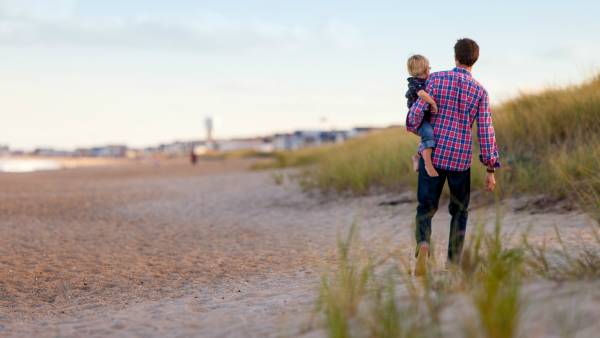Whether planned or unplanned, becoming a parent is one of the most life-changing events that can happen to a person. Recently, I’ve been thinking about all the transitions that take place for men becoming dads, and how natural movement might support these transitions.
Whether planned or unplanned, becoming a parent is one of the most life-changing events that can happen to a person. Recently, I’ve been thinking about all the transitions that take place for men becoming dads, and how natural movement might support these transitions.
I envision many potential ways natural movement could benefit new dads. Since I’m not a parent, however, I reached out to some dedicated young dads for a few different perspectives on fitness and fatherhood. Based on these insights, I’ll be offering some thoughts on how to apply natural movement in philosophy and practice to be the superhero they call “dad.”
Any parent will tell you that, while you can predict and plan, there is really no way to be fully prepared for this life transition. In taking responsibility for someone else, parents are thrust into new roles and challenges.
These changes do not diminish the importance of their health and fitness, but parents must make decisions about how they’ll manage their time and energy. When life shifts, it rattles the foundation of any routine. Health and fitness will inevitably be interrupted, but parents can reclaim balance by integrating new health practices into their parenting.
We’re given broad recommendations for what fitness should look like, but they are often framed as a hobby or obligation more than a way of life. Taking a lifestyle-oriented approach to fitness helps us optimize time and access deeper benefits. Fitness can keep us grounded and help us adjust to changes. Life’s unpredictability is only amplified by becoming a parent. The stakes are raised higher. When it comes to your health and fitness, it’s time to evolve, because it’s no longer just about you.
The Bigger Picture of Fitness
As a parent, every aspect of life is put in a new perspective. Fitness is no longer solely about sculpting a nice body or burning calories. There is a broader awareness that your personal health matters to your family. The idea that fatherhood could lead to a bigger picture understanding of health and fitness was fascinating to me. I had to know more, so I reached out to three health-minded dads in order to get an insider’s glimpse into fitness and fatherhood. Let’s meet them quickly:
- Logan is a self-proclaimed “professional dad” to a 9-month old boy. He recently attended a MovNat certification to learn more about how to make movement a bigger part of everyday life for himself and his family.
- Mike is a long-time friend of mine. He’s a father of two, an ex-Marine, and a firefighter. He’s an active and healthy guy, and trains as an amateur MMA fighter.
- Millar is an EMT from Melbourne. He’s passionate about movement and self-development for new dads. We connected recently on Instagram, and he was kind enough to share his story with me.
These men got deep and shared their experiences on fatherhood. Along the way, common themes emerged, and below I highlight the ways in which the philosophy of natural movement can support the journey through fatherhood.
Mortality and Minimalism
The men described a greater sense of their own mortality. They experienced a shift in perspective that their actions and practices around health are impactful not just to themselves, but their family as well. The ramifications of staying active and eating well became more tangible; their little people served as a constant reminder. This sense of mortality did not make them retreat, but question how they could make the most of their time. Slowly but surely, they began refocusing their priorities on sustainable health and being present for their kids.
“Being a dad, I started to gain a sense of my own mortality. I’m not going to be around forever and I want to make sure I’m healthy and strong for them.” – Mike
“Taking responsibility for myself, my habits, my health, has given me an awareness that transcends movement and applies directly to my ability to parent.” – Logan
Natural movement is an approach to training that develops practical ability and favors minimalism. Strength and mobility are trained to be applied in real-world settings. These qualities are developed for the sake of being helpful to others.
This minimalist approach emphasizes that we maximize benefit with less time and resources. Natural movement teaches us to make the most of situations and environments. Getting a great workout and spending quality time as a family need not be mutually exclusive.
Do you need a million-dollar gym to get your workout? Or just your kid and a climbing tree?
Adaptability and Releasing Expectations
The concept of “the dad bod” is a pop culture reference that has snowballed out of control. The idea is that amidst the new life demands of fatherhood, men will naturally fall out of shape. I asked our fit dads how they managed to stay looking svelte.
They expressed that fitness is something they do for themselves to be the best they can be for their family. Even with less time and more obligations, they maintained fitness as a priority. They admitted that although the nature of their workouts changed, they were willing to let go of their expectations. From their children, they learned adaptability, how to go with the flow.
These values are embodied within natural movement. A training session can take place anywhere, at any time. You train to adapt to your surroundings and accept any outcome. The workouts can work around or involve the kids. The experience becomes one in which fitness and family connection occur simultaneously.
“Fitness was a very regulated, scheduled, boxed in part of my day. Now, I don’t want to compartmentalize my family and my health. Why can’t they be the same? To do this effectively, I make movement a major part of my daily routine and my son participates too (usually as a weight). For me, movement and parenting aren’t two different things I practice, they are just what I do.” – Logan
Communication and Creative Problem Solving
Another common thread that came up was the male tendency to fix what’s broken. As men, we’re hardwired to be problem-solvers. We are conditioned to tackle obstacles head on and use brute force to impose our will. There are areas in life where this approach is successful, parenting is not one of those areas.
“I cannot fix a baby that doesn’t want to eat from a bottle. I cannot “fix” a baby at all. Like you can’t stop a moving train in its tracks, I cannot fight or try to impose my will. Being a dad as taught me that you have to jump on the train and manage the situation from the inside with skill and precision.” – Logan
“I can be very strong-willed at times, and when you have two 6-year-old girls who want a certain something, just arguing it out isn’t going to get you anywhere. I have had to work on my diplomacy, reasoning and communication.” – Millar
The fit dads described the need to improve communication and diplomacy in their interactions with their children. Rather than attempting impose their views by force, they have learned to soften their communication style and explore alternative solutions when issues arise. When tough questions arose, they committed to be being as unbiased as possible. When they did not know how to answer a question they were honest and committed to exploring answers.
We can also see these traditional male values of leadership and competition emerge in fitness and sport; we take charge and go hard towards our goals. Natural movement represents a shift in these ideals. Leadership is reframed through cooperative efforts and outside-the-box thinking.
Traditional fitness focuses on the application of intensity to imposed demands—the approach is straightforward. Natural movement training favors movement complexity and the application of strength and skill to meet the demands of a given environment. This shift may indeed foster the type of thinking that is conducive to effective parenting.
“You become a problem solver. Your kids look to you for answers for everything. It’s ok to not know some things, but I would say that it’s much better to say ‘I don’t know,’ rather than guess and give them wrong information. When it comes to things like war, religion, and sex I try and be as neutral as possible. I try and give both or multiple points of view to my kids, so that they understand that there isn’t always necessarily one ‘right’ way. The same goes for physical activity.” – Millar

Men are wired as problem solvers, but fatherhood requires more soft diplomacy than force of will.
Modeling Behavior
The desire to be a positive role model in lives of their children is also a notable theme. Parents quickly become aware of the sponge-like nature of developing children, and are conscious that their actions speak louder than words. Modeling behaviors of health and fitness set a standard of “normal” human behavior that imprints on children. Kids see that adults exercise and want to imitate.
This is a first step, but in reality, we have it backwards. We encourage our kids to play, but in time, play gives way to a mixture of sports and desk culture. We are now seeing that play holds unique value that exercise does not address, such as variety and mental engagement. Natural movement integrates play and fitness to continue the physical development process we begin in childhood. It models movement as a practice that keep us healthy for a lifetime.
“I was completely into sports as a kid. My dad was more of an intellectual guy. We can already see a lot of my dad in my son. I know he might not be as into sports as I was, but I want him to have good experiences around moving. We’re conscious of not pressuring him into sports, but help him find the activities he loves. I just hope movement stays fun for him.” – Mike
Redefining Masculinity
I asked these guys how their definition of masculinity had changed since becoming dads. Their answers touched me. The common realization was that being masculine is about letting go of stereotypes and standing confidently in your commitments.
These guys described how awkward it initially felt to let their guard down. They had learned to present themselves as stoic and strong, but over time began to see the limitations in this rigid structure. In order to truly connect with their children, these men were happy to take on roles that challenged their traditional ideas of masculinity.
“My views on masculinity have definitely changed; that to be truly masculine is to be supportive, generative, and understanding your feminine qualities. To be truly masculine is about finding your own path or finding your ‘purpose’ and sticking to it.” – Millar
“I used to feel really weird about making up silly songs or dancing around the kitchen with the boy. It just wasn’t manly. I didn’t feel confident doing the soft, cuddly, nurturing stuff that came so easily to my wife. Eventually I figured it out though. One’s masculinity or femininity is not defined from society’s viewpoint, but comes from within. The only way I was being less masculine was by being less confident.” – Logan
Taking on new roles drove an expansion around their ideas of masculinity. They realized that singing and dancing, braiding hair, cooking, cleaning, and playing “make believe” are not inherently masculine or feminine, but parental privileges. These actions challenged their comfort zone and allowed them to develop a deeper sense of masculinity. They focused less on traditional gender roles, and more on internal confidence to define their masculinity.
Natural movement may also assist this expansion of our ideas on masculinity. Dynamic and softer expressions of movement are valued equally. Moving in complex environments creates opportunities to see ourselves in different ways. The context is all of human movement, rather than gender-specific training.

Being masculine doesn’t mean abandoning tenderness, but rather confidence in your purpose.
Natural Movement for Superhero Dads
The themes we’ve explored offer insight into the parallels between parenting and movement. Not only are there strong philosophical connections, but the application can fit well into the busy lives of parents.
Fitness can take on many different forms, but natural movement training is particularly well-suited for dads who strive to be superheroes for their children. Here are a few thoughts on how to bring natural movement training into both your fitness and your fatherhood.
Be a Student
As a parent, you are responsible for the development of your little humans, but understand just how much there is for you to learn along the way. You are simultaneously shaping and being shaped by your kids. Study how your children move through their different developmental stages.
Take note of how mother nature guides them to become competent movers through exploration. As they play at higher levels, see how they don’t require structured programs or periodization to make their gains. Notice that these gains are not just physical, but mental and emotional too.
Incorporate these concepts into your training. Your success as a parent is correlated with your personal development. While guiding your kids to be their best, also recognize they’re teaching you at the same time. Seeing the world through the eyes of a child can help you become a more mindful adult.
Interactive Workouts
It would be easy to claim you cannot get a workout in because there is no one to babysit, but there is a compromise. Let go of the need for an exact structure, and you’ll see new opportunities to train while being with your kids.
Lay in the grass and stretch together. Let them crawl over you while you stay stable. Chase each other in circles. Carry them. Balance on logs. Throw rocks into the lake. I could go on all day, the main point is that what they call “playing” and what you call “training” can be one in the same.
Yes, there will be a new set of parameters. They’ll challenge you to keep exploring, they’ll fuss at times, they’ll want to go longer or pack it in sooner. Adapt. Stay in the moment and make the most of it, and you will create something far beyond fitness.

Is it carrying your kid across the beach, or a loaded, asymmetric, odd object carry on a variable surface? Why not both?
Mobility
Your kids already have all the mobility they need for a childhood full of adventure. You, on the other hand, have been subject to a culture where acceptable adult behavior doesn’t include much movement.
Why don’t you move like they do? Because you’re “old,” or because you’ve been sitting in a chair every day since high school?
Playing with your kids is a chance to reclaim the mobility you’ve lost. Rather than fitting them into the box of how adults move, take cues from them on how to create mobility through more diverse movements. A simple place to start is by getting up and down from the ground.
Move your spine laterally and rotationally, move your limbs in all possible directions from different positions. This may seem abstract, but consider how wrestling match or a game of follow-the-leader would make this all happen organically.
A Child-Optimized Home
Children are constantly learning through their interactions with the environment. This does not stop in childhood, but we do “dumb down” our environments for the sake of excessive safety.
We create homes that are “child-proof,” where every potential danger is neutralized. I advocate for a “child-optimized” home, where serious dangers are accounted for and opportunities to play are abundant. Balance on 2”x4” boards. Set up a web made of string. Build a small climbing wall.
Set up targets to jump to and play “hot lava.” Think of it as play permaculture. Yes, it takes some extra work, but the entire family can benefit from a more sensory-rich living space.
Strength Training
The gym will always be a viable option, but it’s not the only place where strength is built. Your kids will likely be willing training tools. Think of them as the ultimate odd object training. Squat, lunge, hinge, and press them overhead.
The fact that they are precious cargo means you’ll move more mindfully. Go explore nature together and seize the opportunities to lift rocks and logs; hang from playground equipment and trees. Get dirty, defy some social norms, demonstrate that there is value in taking calculated risks. Show them strength is more than a physical endeavor. As you build yourself, you’re imparting strong ideals.
Mold Your Fitness to Your Life
After delving into the stories of these dedicated family men and drawing some parallels to natural movement training, it becomes even more clear that fitness has a higher purpose. It is easy to see fitness as concept that we learn and replicate. Less often do we take the time figure out how to shape our fitness practice to support the roles and responsibilities we take on. Millar sums it up nicely here:
“I’m a firm believer that the kind of training you are doing in your life should match the life situation you are in. When I had just become a dad while in school, I did traditional strength training to support me physically, but more important mentally.
Now I have a bit more free time and am learning about as many different areas of fitness and movement as possible. During this phase in my life I am trying to be as creative as possible for my blog, an educational resource for my children, and also lead by example when it comes to listening and understanding to your body.
What I’m trying to say is that I believe the physical activity you do should be feeding your body and your mind so that it will push you to where you want to be.” – Millar
For those that choose the path of parenthood, it is likely to be the most important role they will play. Fitness can either be another obligation on the to-do list, or it can be an opportunity for self-development and family enrichment.
Natural movement training represents a shift in the approach that can bring men closer to their little ones. Through diverse movement, communication, interaction, and adaptability, men can stay fit and healthy while staying grounded in the bigger picture of being the best caregiver, role model, and mentor possible.
Every dad is a superhero, and natural movement is a way they can fully own it.

Becoming a mom doesn’t mean the end of fitness, either:
Life After Kids: 4 Weeks to Get Your Fitness Back






